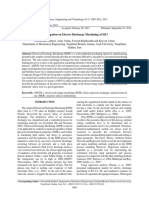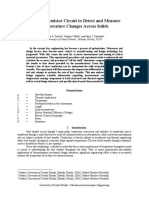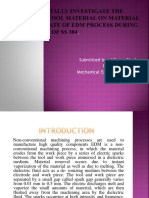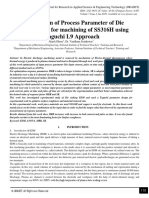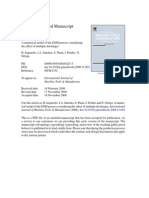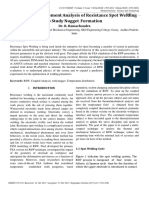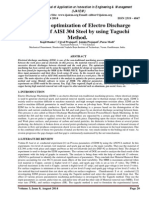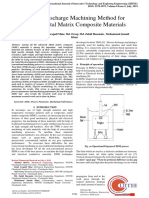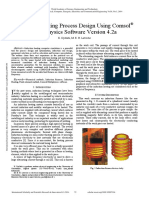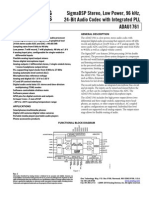Analysis of WEDM Using ANSYS and FEM
Analysis of WEDM Using ANSYS and FEM
Copyright:
Available Formats
Analysis of WEDM Using ANSYS and FEM
Analysis of WEDM Using ANSYS and FEM
Copyright
Available Formats
Share this document
Did you find this document useful?
Is this content inappropriate?
Copyright:
Available Formats
Analysis of WEDM Using ANSYS and FEM
Analysis of WEDM Using ANSYS and FEM
Copyright:
Available Formats
Volume 8, Issue 1, January – 2023 International Journal of Innovative Science and Research Technology
ISSN No:-2456-2165
Analysis of WEDM Using ANSYS and FEM
Dheeraj Shukla*, Ashutosh Dwivedi
Student, Professor(H.O.D.)
Dept. of Mechanical Engineering, Vindhya Institute of Technology and Science, Satna
Abstract:- Wire electrical discharge machining (WEDM) of the part to be machined by the wire electrical discharge
is widely used in machining of conductive materials machining process. In 1975, it was popular rapidly, and its
when precision is considered as a prime importance. capability was better understood by manufacturing industry.
This work proposes a three dimensional finite element When the computer numerical control system was
model (using ANSYS software) and new approach to introduced in WEDM process this brought about a most
predict the temperature distribution at different pulse important development of the machining proce.
time as well as stress distribution in wire. A transient
thermal analysis assuming a Gaussian distribution heat Consequently the wide capability of the wire electrical
source with temperature-dependent material properties discharge machining process was widely exploited for any
has been used to investigate the temperature distribution through-hole machining owing to the wire, which has to
and stress distribution. Thermal stress developed after pass through the part to be machined. The common
the end of the spark and residual stress developed after application of wire electrical discharge machining process is
subsequent cooling. The effect on significant machining the fabricate the stamp and extrusion tools and dies, fixtures
parameter pulse-on-time has been investigated and and gauges, prototypes, aircraft and medical parts, and
found that the peak temperature sharply increases with grinding wheel form tools.
the parameter.
II. MATERIALS AND METHODS
Keywords: ANSYS, WEDM, Residual Stress, Thermal Stress,
Temperature. In the wire EDM, a series of rapid electric spark occur
in the gap between tool (wire) and workpiece. Addition of
I. INTRODUCTION particles into the dielectric fluid makes this process more
complex and random. The following assumptions are made
Wire electrical discharge machining process is a without sacrificing the basic features of the wire EDM
mostly used non-conventional material removal processes. model to make the problem mathematically feasible.
This is use for manufacturing difficult shape and profile of
hard materials. This is considering as a distinctive variation A. Thermal Model of Wire EDM
of the conventional electrical discharge machining The working principal of WEDM is as same EDM
processes. In the WEDM, demand is growing for high rate process, when the distance between the two electrodes (wire
cutting speed and high accuracy machining for improve the and the workpiece) is reduced the intensity of electric field
productivity of product and also for achieve high excellence in the volume between the electrodes (wire and the
quality in machining job. In wire electrical discharge workpiece), become greater than the strength of the
machining process a always travelling wire electrode made dielectric, which breaks, allowing current to flow between
of thin copper, brass or tungsten of diameter 0.05–0.3 mm is the two electrodes. For this reason the spark will generated.
used, which is precisely controlled by a CNC system. Here B. Finite Element Analysis Procedure Using ANSYS
role of CNC is very important. The function of CNC is Software
unwind the wire from a first spool, and feed throughout the
work-piece, and takes it on a second spool. Generally wire Thermal Analysis of Brass Wire
velocity varies from 0.1 to 10 m/min, and feed rate is 2 to 6 The general finite element modeling procedure consists
mm/min. A direct current is used for generate high of the following steps:
frequency pulse to the wire and the workpiece. The wire
(electrode) is hold in tensioning device for decreases the Preferences
chance of producing inaccurate parts. In wire electrical Thermal
machining process, the workpiece and tool is eroded and
there is no direct contact between the workpiece and the Preprocessing
electrode, and this reduces the stress during machining. Definition of Element Type
Material Properties Definition
WEDM was initially developed by manufacturing Model Generation
industry in the since 1960. The development technique is Meshing
replaced the machined electrode used in electrical discharge
machining. In 1974, D.H. Dulebohn introduced the optical
line follower system which is automatic control the shapes
IJISRT23JAN235 www.ijisrt.com 478
Volume 8, Issue 1, January – 2023 International Journal of Innovative Science and Research Technology
ISSN No:-2456-2165
Solution Thermal>Heat Flux>On Element>Select Proper
Defining Initial Condition Element>Ok
Applying Boundary Condition Initial Condition>Define>Pick All>Temperature>210C
Applying Load Solve >Current LS
Solving For Results
Post Processing>Plot Results>Counter Plot>Nodal
Post Processing Solution>DOF Solution>Nodal Temperature>OK
Reading Result File Finish
Viewing Results Physics> Environment>Read >Structural>Ok
Solution Control>Putting The Ton Time> Automatic
Process of Thermo-Structural Modeling Time Stepping ON>No. Of Subsets
Open Mechanical Apdl (Ansys). Apply>Structural>Displacement>Area>All DOF>OK
Go To File > Change Title And Give A New Title For Solution Load Step>Write LS File>1>Ok
The Example. Analysis Type>Solution Control>Basic>Off
Preferences Time>Transient>Ramped Loading
Preprocessing>Element Type> Add/Edit/Delete Defineload>Apply>Temperature>From Thermal
Analysis>Brouse>File.Rth>Ok
Click on Add
Select Thermal Solid on the Left List and Brick 8 Node Post processing>plot results>counter plot>nodal
70 on Right List(I.E. Element Type) Click on Ok solution>DOF solution>nodal temperature>OK
Close
Material Properties>Temperature Unit>Celsius>Ok III. RESULTS AND DISCUSSION
Material Models>Thermal >Conductivity>Isotropic>Ok
,Put Value>Density Put Value>Specific Heat Put A. ANSYS Model Confirmation
Value>Material Exit In this section we have firstly make a model of WEDM
Modeling>Create>Cylinder>Sold Cylinder>Put the process for brass wire with parameter setting as given in
Dimensions Table 3. Later the value has been compared with Han et al.
Meshing>Mesh Tool> Smart Size 6>Mesh >Ok Fig. 6 shows temperature distribution in brass wire, which is
approximately same of Han et al. model. So we can say that
we are proceeding in right way. Thermal modeling has done
in using ANSYS.
B. FEM Analysis
Thermal Modeling of Wire EDM for Single Spark in
Brass Wire
Main parameters of the thermal analysis (analysis
parameters)
Table 1 Parameters Used for Thermal Analysis in
WEDM Process
Parameter Unit Value
Peak current of electro- A 27
discharge
Voltage of electro V 25
discharge,
Fig 1 Three-Dimensional View of the Meshed Model Duration of single pulse µs 0.12, 0.26, 0.36,
0.52, 0.58,
Physics> Environment>Write >Physics File Wire radius Mm 1.2, 1.82
Title>Thermal>Ok Convective coefficient W/m2 0C 0.05
Element Type>Switch Element Type>Change>Element Temperature of the 0C 3040
Type>Thermal To Structural>Ok dielectric Poisson’ ratio
Material Coefficient of linear K1 21
Properties>Structural>Linear>Isotropic>Thermal thermal expansion
Expansion>Ok>Exit
Physics> Environment>Write >Erase Thermal>Write
Structural>Ok
Solution>New Analysis Type>Transient>Full>Ok
Solution Control>Putting The Ton Time> Automatic
Time Stepping ON>No. Of Subsets
Define Loads>Apply>Functions>Read File>Ok
IJISRT23JAN235 www.ijisrt.com 479
Volume 8, Issue 1, January – 2023 International Journal of Innovative Science and Research Technology
ISSN No:-2456-2165
Fig 2 Temperature Distribution In Brass Wire With V=25V, Fig 5 Temperature Distribution In Brass Wire With V=25V,
I=27 A, P=0.38 And Ton=0.12µs I=27 A, P=0.38 And Ton=0.52µs
Fig 3 Temperature Distribution In Brass Wire With V=25V, Fig 6 Temperature Distribution In Brass Wire With V=25V,
I=27 A, P=0.38 And Ton=0.26µs I=27 A, P=0.38 And Ton=0.58µs
Fig 4 Temperature Distribution In Brass Wire With V=25V, Fig 7 Temperature Distribution In Brass Wire With V=25V,
I=27 A, P=0.38 And Ton=0.36µs I=27 A, P=0.38 And Ton=1.2µs
IJISRT23JAN235 www.ijisrt.com 480
Volume 8, Issue 1, January – 2023 International Journal of Innovative Science and Research Technology
ISSN No:-2456-2165
Fig 8 Temperature Distribution In Brass Wire With V=25V,
I=27 A, P=0.38 And Ton= 1.82µs
Structural Modeling of WEDM in Molybdenum Wire
Fig 10 Graph of Displacement
In this section we have firstly make a model of WEDM
process for brass wire with parameter setting as given in
Thermo-Structural Analysis of WEDM in Brass Wire.
Table 4. Later the value has been compared with Saha et al.
Thermal Stress Modelling of Micro Wire EDM for Single
Fig. 6 shows displacement molybdenum wire, which is
Discharge
approximately same of Saha et al. So we can say that we are
proceeding in right way. The structural analysis has done of
molybdenum wire.
Displacement Analysis in the Wire Due to Tension:
After solving for the temperature distribution we
attempt to find the displacement in the wire. Now in this
case molybdenum wire is used. Process parameters used for
analysis is shown below Table 2
Table 2 Parameters used for structural analysis in
WEDM process
Parameter Units Value
Radius of wire Mm 0.125
Length of wire M
Tension N 0.1
Initial K
temperature Fig 11 Thermal Stress in X-Component at Ton=0.12µs
Working K 13.7295
The displacement graph is shown in below:
Fig 12 Thermal Stress in Y-Component at Ton=0.12µs
Fig 9 Nodal Solution of Displacement
IJISRT23JAN235 www.ijisrt.com 481
Volume 8, Issue 1, January – 2023 International Journal of Innovative Science and Research Technology
ISSN No:-2456-2165
Fig 16 Thermal Shear Stress in YZ-Component at
Fig 13 Thermal Stress in Z-Component at Ton=0.12µs Ton=0.12µs
Fig 14 Thermal Shear Stress in XY Component at
Ton=0.12µs Fig 17 Residual Stress at Toff = 3µs
Fig 15 Thermal shear stress in XZ component at ton=0.12µs Fig 18 Thermal Stress in X-Component at Ton=0.52µs
IJISRT23JAN235 www.ijisrt.com 482
Volume 8, Issue 1, January – 2023 International Journal of Innovative Science and Research Technology
ISSN No:-2456-2165
Fig 22 Thermal Shear Stress in YZ-Component at
Fig 19 Thermal Stress in Y-component at ton=0.52µs Ton=0.52µs
Fig 20 Thermal Stress in Z-Component at Ton=0.52µs Fig 23 Residual Stress at toff= 3µs
Fig 21 Thermal Shear Stress in XY-Component at Fig 24 Thermal Stress in X-Component at Ton=1.82µs
Ton=0.52µs
IJISRT23JAN235 www.ijisrt.com 483
Volume 8, Issue 1, January – 2023 International Journal of Innovative Science and Research Technology
ISSN No:-2456-2165
Fig 25 Thermal Stress in Y-Component at ton=1.82µs Fig 28 Thermal Stress in XZ-Component at ton=1.82µs
Fig 26 Thermal Stress in Z-Component at Ton=1.82µs Fig 29 Thermal Stress in YZ-Component at ton=1.82µs
Fig 30 Residual Stress at Toff= 3 µs 2.5 Results and
Discussions
Temperature distributions at the end of the pulse time
Fig 27 Thermal Stress in XY-Component at Ton=1.82µs
are shown in Figs.(3- 9) to know the effects on WEDM. The
IJISRT23JAN235 www.ijisrt.com 484
Volume 8, Issue 1, January – 2023 International Journal of Innovative Science and Research Technology
ISSN No:-2456-2165
temperature distribution during single discharge is 578.3350C. At pulse time = 1.2 µs, corresponding
calculated with the energy input constant parameter Ip= 27 temperature is 854.80C. At pulse time = 1.82 µs,
A, voltage =25V with varying pulse time. At pulse time = corresponding temperature is 11440C and the maximum
0.12 µs, corresponding temperature is 86.750C. At pulse compressive stress is 425Mpa for ton=1.82µs in Z-
time = 0.26 µs, corresponding temperature is 247.70C. At component, and maximum residual stress is 533 Mpa.
pulse time = 0.36 µs, corresponding temperature is 318.60C.
At pulse time = 0.52 µs, corresponding temperature is Further increasing the pulse time is not possible
446.90C. At pulse time = 0.58 µs, corresponding because, at temperature 10830C, the brass wire melt.
temperature is 578.3350C. At pulse time = 1.2 µs,
corresponding temperature is 854.80C. At pulse time = 1.82 REFERENCES
µs, corresponding temperature is 11440C. Further increasing
the pulse time is not possible because, at temperature [1]. Datta, S. and Mahapatra, S.S. (2010)Modeling,
10830C, the brass wire melt. simulation and parametric optimization of wire EDM
process using response surface methodology coupled
The distinctive stress distributions in WEDM process, with grey-Taguchi technique,
enumerated at the end of heating cycle are presented. Here, [2]. International Journal of Engineering, Science and
Gaussian heat flux distribution is used for the calculation of Technology, vol. 2, pp. 162-183.
temperature distribution. Later on, by varying the parameter [3]. Kunieda, K. and Furudate, C. (2001) High Precision
i.e. pulse duration, and study of thermal stresses are Finish Cutting by Dry WEDM, Journal of Materials
presented. Fig 10-34 shows the thermal stress in different Processing Technology, vol. 149 pp. 77–82
pulse on time. Thermal stress developed after the end of the [4]. Okada, O., Uno, Y., Nakazawa, M. and Yamauchi, T.
spark and residual stress developed after subsequent (2010) Evaluations of spark distribution and wire
cooling. The nature of the maximum stress is compressive, vibration in wire EDM by high-speed. Manufacturing
and it is because during the pulse duration, the heat flux Technology, vol.59, pp. 231–234
supplied to the tool electrode for a very short duration (in [5]. Cabanesa, I., Portilloa, E., Marcosa, M. and
μs).The maximum compressive stress is 563MPa for Sa´nchezb, J.A. ( 2 0 0 8 ) An industrial application
ton=0.12µs in X-component, and maximum residual stress is for on-line detection of instability and wire breakage
778 MPa. The maximum compressive stress is 288Mpa for in wire EDM, journal of materials processing
ton=0.52µs in Z-component and maximum residual stress is technology, vol. 1 9 5, pp. 101–109
288 MPa. The maximum compressive stress is 425Mpa for [6]. Saha, S., Pachon, M., Ghoshal, A.and Schulz d, M.J.
ton=1.82µs in Z-component and maximum residual stress is (2004) Finite element modeling and optimization to
533 MPa. prevent wire breakage in electro-discharge machining
Mechanics, Research Communications, vol. 31,pp.
IV. SUMMARY AND CONCLUSION 451–463Hou, P.J., Guo, Y.F., Sun, L.X. and Deng
G.Q. ( 2013 ) Simulation of temperature and thermal
In this dissertation, a robust three dimensional finite stress filed during reciprocating traveling WEDM of
element model has been developed using ANSYS software insulating ceramics, Procedia CIRP vol. 6 PP. 410 –
to predict the temperature distribution at different pulse time 415
as well as stress distribution in the wire of WEDM. A [7]. Hada, K. and Kunieda, M. (2013) Analysis of wire
transient thermal analysis assuming a Gaussian distribution impedance in wire-EDM considering
heat source with temperature-dependent material properties Electromagnetic fields generated around wire
has been used to investigate the temperature distribution and electrode, Procedia CIRP vol.6 245 – 250
stress distribution. Thermal stress was developed after the [8]. Cabanesa, I., Portilloa, E., Marcosa, M. and
end of the spark and also residual stress was developed after Sa´nchezb, J.A. (2 0 0 8) On-line prevention of wire
subsequent cooling. Finite element modeling was carried out breakage in wire electro-discharge machining,
for a single spark with temperature-dependent material Robotics and Computer-Integrated Manufacturing,
properties. Certain parameters such as spark radius, vol. 24, pp. 287-289.
discharge current and discharge duration, the latent heat, the [9]. Cheng, G., Zhijing, H.and Feng (2007) Experimental
plasma channel radius and Gaussian distribution of heat determination of convective heat transfer coefficient
flux, the percentage of discharge energy transferred to the in WEDM, International Journal of Machine Tools
tool electrode have made this study nearer to real process & Manufacture, vol. 47,pp. 1744–1751
conditions. The FE model shows that, at pulse time = 0.12 [10]. Yan, M.T. and Lai, Y.P. (2007) Surface quality
µs, corresponding temperature is 86.750C and maximum improvement of wire-EDM using a fine-finish power
residual stress is 778 Mpa. At pulse time = 0.26 µs, supply, International Journal of Machine Tools &
corresponding temperature is 247.70C and .At pulse time = Manufacture, vol.47, pp. 1686–
0.36 µs, corresponding temperature is 318.60C. At pulse [11]. 1694Cabanesa, I., Portilloa, E., Marcosa, M. and
time = 0.52 µs, corresponding temperature is 446.90C and Sa´nchezb, J.A. (2 0 0 8) On-line prevention of wire
the maximum compressive stress is 288Mpa in Z- breakage in wire electro-discharge machining,
component, and maximum residual stress is 288 Mpa. . At Robotics and Computer-Integrated Manufacturing,
pulse time = 0.58 µs, corresponding temperature is vol. 24, pp. 287-289.
IJISRT23JAN235 www.ijisrt.com 485
You might also like
- Electronics Technician ReviewerDocument10 pagesElectronics Technician ReviewerAlpyn100% (4)
- Industrial Applications of Infrared Thermography: How Infrared Analysis Can be Used to Improve Equipment InspectionFrom EverandIndustrial Applications of Infrared Thermography: How Infrared Analysis Can be Used to Improve Equipment InspectionRating: 4.5 out of 5 stars4.5/5 (3)
- Finite Element Analysis of Wire Electrode On WEDM Process Using ANSYSDocument14 pagesFinite Element Analysis of Wire Electrode On WEDM Process Using ANSYSIJRASETPublicationsNo ratings yet
- Experimental Investigation of Process Parameters On Inconel 925 For EDM Process by Using Taguchi MethodDocument6 pagesExperimental Investigation of Process Parameters On Inconel 925 For EDM Process by Using Taguchi MethodVishal Kumar JaiswalNo ratings yet
- Estimation of Effect of Process Parameters On Temperature, Thermal and Residual Stresses in Edmed Aisi D2 Steel ComponentsDocument6 pagesEstimation of Effect of Process Parameters On Temperature, Thermal and Residual Stresses in Edmed Aisi D2 Steel ComponentsJose Velasquez TeranNo ratings yet
- Investigation On Electro Discharge Machining of H13Document10 pagesInvestigation On Electro Discharge Machining of H13Nguyễn Hữu PhấnNo ratings yet
- Lab 1A - Heat Transfer Through Aluminum Rod PDFDocument10 pagesLab 1A - Heat Transfer Through Aluminum Rod PDFJoshua KravitzNo ratings yet
- Modeling of Electro Discharge Machining in Aisi 304 Material Ijariie1221 Volume 1 13 Page 188 197Document10 pagesModeling of Electro Discharge Machining in Aisi 304 Material Ijariie1221 Volume 1 13 Page 188 197Eric CookNo ratings yet
- A Review Paper On (EDM) Electrical Discharge MachiningDocument3 pagesA Review Paper On (EDM) Electrical Discharge MachiningVishal Kumar JaiswalNo ratings yet
- Submitted By:-Vikram Singh Roll No:-2511666 Mechanical Engineering DeptDocument45 pagesSubmitted By:-Vikram Singh Roll No:-2511666 Mechanical Engineering DeptManjeet BohatNo ratings yet
- Optimization of Process Parameter of Die Sinking EDM For Machining of SS316H Using Taguchi L9 ApproachDocument12 pagesOptimization of Process Parameter of Die Sinking EDM For Machining of SS316H Using Taguchi L9 ApproachIJRASETPublicationsNo ratings yet
- COPEN PaperDocument6 pagesCOPEN PaperADABALA SUBRAHMANYAMNo ratings yet
- A numerical model of the EDM process considering the effect of multiple discharges PDFDocument46 pagesA numerical model of the EDM process considering the effect of multiple discharges PDFAhmadMechNo ratings yet
- Thermal Analysis On Power Amplifier UsedDocument7 pagesThermal Analysis On Power Amplifier UsediiphlabsNo ratings yet
- Determination of Material Removal Rate in Electro Discharge Machining Through Copper ElectrodeDocument7 pagesDetermination of Material Removal Rate in Electro Discharge Machining Through Copper ElectrodeIJRASETPublicationsNo ratings yet
- Development of Temperature Measurement Setup For MDocument6 pagesDevelopment of Temperature Measurement Setup For MBalázs SimonNo ratings yet
- Electro Discharge Machine: Metereology & Machining LabDocument5 pagesElectro Discharge Machine: Metereology & Machining LabSumit JadhavNo ratings yet
- Investigating Effects of Process Variables On MRR in EDM by Using Taguchi Parameter Design ApproachDocument6 pagesInvestigating Effects of Process Variables On MRR in EDM by Using Taguchi Parameter Design ApproachPujara ManishNo ratings yet
- Ijmet: ©iaemeDocument9 pagesIjmet: ©iaemeIAEME PublicationNo ratings yet
- Optimization of Various Machining Parameters of Electrical Discharge Machining (EDM) Process On AISI D2 Tool Steel Using Hybrid Optimization MethodDocument9 pagesOptimization of Various Machining Parameters of Electrical Discharge Machining (EDM) Process On AISI D2 Tool Steel Using Hybrid Optimization MethodInternational Journal of Application or Innovation in Engineering & ManagementNo ratings yet
- Temperature Field Simulation of Wire Electrode in High-Speed and Medium-Speed WEDM Under Moving Heat SourceDocument6 pagesTemperature Field Simulation of Wire Electrode in High-Speed and Medium-Speed WEDM Under Moving Heat SourceÐɤ Suman ChatterjeeNo ratings yet
- Chapter 1 - Introduction EDMDocument5 pagesChapter 1 - Introduction EDMPraveen RnNo ratings yet
- Optimization of Process Parameters in Die Sinking EDM - A REVIEWDocument6 pagesOptimization of Process Parameters in Die Sinking EDM - A REVIEWIJSTENo ratings yet
- Performance Capabilities of EDM Machining Using Aluminum, Brass and Copper For AISI 304L MaterialDocument6 pagesPerformance Capabilities of EDM Machining Using Aluminum, Brass and Copper For AISI 304L MaterialInternational Journal of Application or Innovation in Engineering & ManagementNo ratings yet
- Demidovich 2016Document4 pagesDemidovich 2016rahim oneNo ratings yet
- Experiment - 5-Wire Electrical Discharge MachiningDocument19 pagesExperiment - 5-Wire Electrical Discharge MachiningdmupscresourceNo ratings yet
- Design of Pulse Circuit of EDM DiesinkerDocument4 pagesDesign of Pulse Circuit of EDM DiesinkerPieter VeendersNo ratings yet
- Temperature Measurement in Single Point TurningDocument9 pagesTemperature Measurement in Single Point TurningRenato NunesNo ratings yet
- Heat Transfer in High-Voltage Surge ArrestersDocument4 pagesHeat Transfer in High-Voltage Surge Arresterscik_sya87No ratings yet
- Report On Self Driving CarDocument23 pagesReport On Self Driving CarAnonymous 8zeEYkNo ratings yet
- # 5 Electro Discharge MachiningDocument117 pages# 5 Electro Discharge MachiningRohan RautNo ratings yet
- Research PaperDocument11 pagesResearch PaperChandra SekarNo ratings yet
- Dieless Wire Drawing-An Experimental and Numerical Analysis: P. Tiernan, M.T. HilleryDocument6 pagesDieless Wire Drawing-An Experimental and Numerical Analysis: P. Tiernan, M.T. HillerycostytzuNo ratings yet
- Study On Finite Element Analysis of ResiDocument6 pagesStudy On Finite Element Analysis of ResiTapasNo ratings yet
- EDM Notes2Document13 pagesEDM Notes2Revathi ChandruNo ratings yet
- Parameter Optimization of Electro Discharge Machine of AISI 304 Steel by Using Taguchi MethodDocument5 pagesParameter Optimization of Electro Discharge Machine of AISI 304 Steel by Using Taguchi MethodInternational Journal of Application or Innovation in Engineering & ManagementNo ratings yet
- EDM1Document6 pagesEDM1Shreyasi17No ratings yet
- EdmDocument29 pagesEdmGaurav SinghNo ratings yet
- Aghdeab 2021 IOP Conf. Ser. Mater. Sci. Eng. 1094 012074Document7 pagesAghdeab 2021 IOP Conf. Ser. Mater. Sci. Eng. 1094 012074raed rasheedNo ratings yet
- ME20B145E8B15Document5 pagesME20B145E8B15Rahul me20b145No ratings yet
- Fulltext01 PDDocument7 pagesFulltext01 PDAbraham Dominguez SandovalNo ratings yet
- Review of State of Art and Process Parameter Influence in EDM TechnologyDocument9 pagesReview of State of Art and Process Parameter Influence in EDM TechnologyNguyễn Hữu PhấnNo ratings yet
- DPR - RPT by EDMDocument11 pagesDPR - RPT by EDMswapnil pandeNo ratings yet
- Electric Discharge Machining Method ForDocument12 pagesElectric Discharge Machining Method Forraviteja tankalaNo ratings yet
- Infrared Measurement of The Temperature at The Tool-Chip Interface While Machining Ti-6Al-4VDocument9 pagesInfrared Measurement of The Temperature at The Tool-Chip Interface While Machining Ti-6Al-4VchandanNo ratings yet
- ProjetsDocument8 pagesProjetszoombaarichNo ratings yet
- Design and Simulation of A Spot Welding Process: February 2019Document7 pagesDesign and Simulation of A Spot Welding Process: February 2019Abdullah hussainNo ratings yet
- Magesh 2017A Review of Process Parameter of EDM Ijariie7176Document4 pagesMagesh 2017A Review of Process Parameter of EDM Ijariie7176vijayaragavanNo ratings yet
- Title: Objective: Electrode Discharge Machine Wirecut (EDM Wirecut)Document23 pagesTitle: Objective: Electrode Discharge Machine Wirecut (EDM Wirecut)Nur Shaheera Zainurin33% (3)
- A Simple Thermistor Design For Industrial TemperatDocument11 pagesA Simple Thermistor Design For Industrial TemperatBimal JalanNo ratings yet
- CNC WirecutDocument6 pagesCNC WirecutUmair RaisNo ratings yet
- FSW AnalysisDocument35 pagesFSW AnalysisChinmay Dave100% (1)
- End Shiv Seminar ReportDocument21 pagesEnd Shiv Seminar Reportmohitmemitrc2020No ratings yet
- Thermal Design of T/R Modules in Airborne Phased Array AntennaDocument4 pagesThermal Design of T/R Modules in Airborne Phased Array AntennailkebayrakgercekNo ratings yet
- Electrical Discharge MachiningDocument30 pagesElectrical Discharge MachiningParas MalhotraNo ratings yet
- Induction Heating Process Design Using Comsol Multiphysics Software Version 42aDocument4 pagesInduction Heating Process Design Using Comsol Multiphysics Software Version 42areaktorenergiNo ratings yet
- Improved Electrical Discharge Machine (EDM) Servomechanism Controller For Machining Micro PitsDocument6 pagesImproved Electrical Discharge Machine (EDM) Servomechanism Controller For Machining Micro PitsKevin WellsNo ratings yet
- Experimental Investigation of MRR Using EDMDocument6 pagesExperimental Investigation of MRR Using EDMANKITNo ratings yet
- Temp Measurement PPT 2020Document57 pagesTemp Measurement PPT 20202K18/AE/049 SARTHAK THAREJANo ratings yet
- Cryogenic EDM, Abhinav SharmaDocument7 pagesCryogenic EDM, Abhinav Sharmaabhinav sharmaNo ratings yet
- Facial Expression-Based Emotion Detection for Adaptive Teaching in Educational EnvironmentsDocument7 pagesFacial Expression-Based Emotion Detection for Adaptive Teaching in Educational EnvironmentsInternational Journal of Innovative Science and Research TechnologyNo ratings yet
- Climate Adaptation and Capturing Innovative and Best Practices of Sudan Funded Projects for Knowledge ManagementDocument6 pagesClimate Adaptation and Capturing Innovative and Best Practices of Sudan Funded Projects for Knowledge ManagementInternational Journal of Innovative Science and Research TechnologyNo ratings yet
- Sustainability in Alcohol Production: An Overview of Green Initiatives and their Impact on the IndustryDocument5 pagesSustainability in Alcohol Production: An Overview of Green Initiatives and their Impact on the IndustryInternational Journal of Innovative Science and Research TechnologyNo ratings yet
- AI-Driven Algorithms: Transforming Customer Engagement with AI and Ethical Data PrivacyDocument9 pagesAI-Driven Algorithms: Transforming Customer Engagement with AI and Ethical Data PrivacyInternational Journal of Innovative Science and Research TechnologyNo ratings yet
- The Impact of Price, Facilities and Experience in Maintaining the Sustainable Loyalty of Air Asia Passengers Using Satisfaction as a Mediating VariableDocument11 pagesThe Impact of Price, Facilities and Experience in Maintaining the Sustainable Loyalty of Air Asia Passengers Using Satisfaction as a Mediating VariableInternational Journal of Innovative Science and Research Technology100% (1)
- Phenotypic Diversity Assessment and Related Indigenous Knowledge of Yam (Dioscorea spp) in Ebonyi State, NigeriaDocument112 pagesPhenotypic Diversity Assessment and Related Indigenous Knowledge of Yam (Dioscorea spp) in Ebonyi State, NigeriaInternational Journal of Innovative Science and Research TechnologyNo ratings yet
- Next-Gen Talent Matching System: Innovating Recruitment with AI-Driven JD and CV MatchingDocument5 pagesNext-Gen Talent Matching System: Innovating Recruitment with AI-Driven JD and CV MatchingInternational Journal of Innovative Science and Research TechnologyNo ratings yet
- Spam Detection Using Large Datasets with Multilingual SupportDocument7 pagesSpam Detection Using Large Datasets with Multilingual SupportInternational Journal of Innovative Science and Research TechnologyNo ratings yet
- Adapting 'Rishi-Krishi' Perspectives in Safe Farming in Aadhikhola, Gandaki Province, NepalDocument10 pagesAdapting 'Rishi-Krishi' Perspectives in Safe Farming in Aadhikhola, Gandaki Province, NepalInternational Journal of Innovative Science and Research Technology100% (1)
- Fatigue Failure Analysis of Notched Specimen with En19, En354 and En36c MaterialsDocument7 pagesFatigue Failure Analysis of Notched Specimen with En19, En354 and En36c MaterialsInternational Journal of Innovative Science and Research TechnologyNo ratings yet
- Enhancing Biogas Yield by Co-Digestion of Cattle Dung and Acha (Digitaria Exilis) HullsDocument8 pagesEnhancing Biogas Yield by Co-Digestion of Cattle Dung and Acha (Digitaria Exilis) HullsInternational Journal of Innovative Science and Research TechnologyNo ratings yet
- Optimizing Maternal Nutrition and its Impact on Fetal Development: Evidence-Based Insights and Current GuidelinesDocument4 pagesOptimizing Maternal Nutrition and its Impact on Fetal Development: Evidence-Based Insights and Current GuidelinesInternational Journal of Innovative Science and Research TechnologyNo ratings yet
- Functionality of Google Maps and Parameter-based Efficient Eateries route DetectionDocument8 pagesFunctionality of Google Maps and Parameter-based Efficient Eateries route DetectionInternational Journal of Innovative Science and Research TechnologyNo ratings yet
- Determinants of the Exploitation of Groundwater Resources of the Alluvial Plain of KarfiguelaDocument4 pagesDeterminants of the Exploitation of Groundwater Resources of the Alluvial Plain of KarfiguelaInternational Journal of Innovative Science and Research TechnologyNo ratings yet
- Examining How Police as a Security Function Fosters Socio-Economic Development in KenyaDocument16 pagesExamining How Police as a Security Function Fosters Socio-Economic Development in KenyaInternational Journal of Innovative Science and Research TechnologyNo ratings yet
- Application of Gestalt Theory in Interior Design Dinas Perpustakaan Dan Kearsipan Daerah Provinsi Jawa Barat (DISPUSIPDA)Document10 pagesApplication of Gestalt Theory in Interior Design Dinas Perpustakaan Dan Kearsipan Daerah Provinsi Jawa Barat (DISPUSIPDA)International Journal of Innovative Science and Research TechnologyNo ratings yet
- The Impact of Infectious Diseases on Global Health Systems: Challenges and Strategies for PreventionDocument7 pagesThe Impact of Infectious Diseases on Global Health Systems: Challenges and Strategies for PreventionInternational Journal of Innovative Science and Research TechnologyNo ratings yet
- Nurses’ Knowledge Regarding Management of Burn Injury Patients at Selected Hospital in Dhaka, BangladeshDocument16 pagesNurses’ Knowledge Regarding Management of Burn Injury Patients at Selected Hospital in Dhaka, BangladeshInternational Journal of Innovative Science and Research TechnologyNo ratings yet
- Exploring the Role of Human Behavior Analytics in Strengthening Privacy-Preserving Systems for Sensitive Data ProtectionDocument16 pagesExploring the Role of Human Behavior Analytics in Strengthening Privacy-Preserving Systems for Sensitive Data ProtectionInternational Journal of Innovative Science and Research TechnologyNo ratings yet
- Technological Innovations in Osteoporosis Diagnosis and their Implications for Bone Metastases Management in OncologyDocument15 pagesTechnological Innovations in Osteoporosis Diagnosis and their Implications for Bone Metastases Management in OncologyInternational Journal of Innovative Science and Research TechnologyNo ratings yet
- A Study at Bal Rugnalay in Paratwadha Maharastra to Provide Teaching Program Plan and to Assess Effectiveness of Non Nutritive Sucking or Pacifier in Promoting Physiologic Stability and Nutritional Status among Preterm Infants Admitted in NICUDocument7 pagesA Study at Bal Rugnalay in Paratwadha Maharastra to Provide Teaching Program Plan and to Assess Effectiveness of Non Nutritive Sucking or Pacifier in Promoting Physiologic Stability and Nutritional Status among Preterm Infants Admitted in NICUInternational Journal of Innovative Science and Research TechnologyNo ratings yet
- Aetiology of Hearing Loss in Cochlear Implantees: A Study of 191 Cases at CI Centre, CMH, DhakaISRT24DEC453Document6 pagesAetiology of Hearing Loss in Cochlear Implantees: A Study of 191 Cases at CI Centre, CMH, DhakaISRT24DEC453International Journal of Innovative Science and Research TechnologyNo ratings yet
- Perception of Victim Blaming: Basis for Community EducationDocument6 pagesPerception of Victim Blaming: Basis for Community EducationInternational Journal of Innovative Science and Research TechnologyNo ratings yet
- A Field Survey to Investigate the Flora of Dharmashala Dhauladhar Range in North-Western Himalayan Region of IndiaDocument13 pagesA Field Survey to Investigate the Flora of Dharmashala Dhauladhar Range in North-Western Himalayan Region of IndiaInternational Journal of Innovative Science and Research TechnologyNo ratings yet
- Chronic Low-Grade Systemic Inflammatory State and Insulin Resistance: Implications for Metabolic HealthDocument14 pagesChronic Low-Grade Systemic Inflammatory State and Insulin Resistance: Implications for Metabolic HealthInternational Journal of Innovative Science and Research TechnologyNo ratings yet
- Estimation of Input Vector Pair from Embedded Space Vector Corresponding to the Framework Based on Spacer Component Matrices: A Constrained Optimization based ApproachDocument13 pagesEstimation of Input Vector Pair from Embedded Space Vector Corresponding to the Framework Based on Spacer Component Matrices: A Constrained Optimization based ApproachInternational Journal of Innovative Science and Research TechnologyNo ratings yet
- Optimising Web Application Development Using Ruby on Rails, Python, and Cloud-Based ArchitecturesDocument10 pagesOptimising Web Application Development Using Ruby on Rails, Python, and Cloud-Based ArchitecturesInternational Journal of Innovative Science and Research TechnologyNo ratings yet
- Effect of Nanotechnology in Orthodontic Materials : An OverviewDocument6 pagesEffect of Nanotechnology in Orthodontic Materials : An OverviewInternational Journal of Innovative Science and Research TechnologyNo ratings yet
- Perceived Cognitive Skills in Chemistry through Case-Based Learning ApproachDocument17 pagesPerceived Cognitive Skills in Chemistry through Case-Based Learning ApproachInternational Journal of Innovative Science and Research TechnologyNo ratings yet
- The Important Role of Information Systems Auditing in Compliance and Risk Management ReviewDocument6 pagesThe Important Role of Information Systems Auditing in Compliance and Risk Management ReviewInternational Journal of Innovative Science and Research TechnologyNo ratings yet
- Computer Science Class 12 Project-C++Document14 pagesComputer Science Class 12 Project-C++Harsh MishraNo ratings yet
- Ingenico Ict250 en 1Document2 pagesIngenico Ict250 en 1Saso MangeNo ratings yet
- MCSA 2016 (Microsoft Certified Solutions Associate) : 70 740 Installation, Storage, and Compute With Windows Server 2016Document3 pagesMCSA 2016 (Microsoft Certified Solutions Associate) : 70 740 Installation, Storage, and Compute With Windows Server 2016girirajNo ratings yet
- Petroleum Engine Caterpillar Engine Specifications: V-8, 4-Stroke-Cycle DieselDocument4 pagesPetroleum Engine Caterpillar Engine Specifications: V-8, 4-Stroke-Cycle DieselRichard Gregorio Huamani Huaman100% (1)
- Irfan AhmedDocument3 pagesIrfan AhmedasadnawazNo ratings yet
- CPP Project Planning Report NewDocument30 pagesCPP Project Planning Report NewPratiksha JadhavNo ratings yet
- Windows Server 2016Document35 pagesWindows Server 2016Rahmad Husein HarahapNo ratings yet
- Laravel Docs 4.2Document181 pagesLaravel Docs 4.2luisNo ratings yet
- WWW Mywifiext - Net - Mywifiext Setup WizardDocument15 pagesWWW Mywifiext - Net - Mywifiext Setup WizardmywifiextenNo ratings yet
- S4 HANA Training SyllabusDocument2 pagesS4 HANA Training Syllabussangram_gNo ratings yet
- Qr204 A2 User Manual 1Document7 pagesQr204 A2 User Manual 1alaska112No ratings yet
- LMV 932 NationalDocument19 pagesLMV 932 NationalAdam SchwemleinNo ratings yet
- DTC C0278/11 Open in ABS Solenoid Relay Circuit DTC C0279/12 Short To B+ in ABS Solenoid Relay CircuitDocument3 pagesDTC C0278/11 Open in ABS Solenoid Relay Circuit DTC C0279/12 Short To B+ in ABS Solenoid Relay CircuitMehwish MehboobNo ratings yet
- MOC.20687A.configuring - Windows.8.setup - Guide.trainer - handBook.2012.RETAiL - Ebook LMSDocument528 pagesMOC.20687A.configuring - Windows.8.setup - Guide.trainer - handBook.2012.RETAiL - Ebook LMSMartin BarbarozasNo ratings yet
- Part 177 BS en 287-1 and BS en Iso 9606-1 For Welder QualificationDocument2 pagesPart 177 BS en 287-1 and BS en Iso 9606-1 For Welder Qualificationravindra_jivaniNo ratings yet
- ADAU1761Document92 pagesADAU1761Constantine SinanasNo ratings yet
- Ec-Pdc Lab ManualDocument88 pagesEc-Pdc Lab ManualSanjitha KurugantiNo ratings yet
- Indra Pariavaran BhawanDocument6 pagesIndra Pariavaran BhawanAnkit Kashmiri GuptaNo ratings yet
- Firecel SR 104: Fire Resistant CableDocument2 pagesFirecel SR 104: Fire Resistant CableDenis BuonoNo ratings yet
- Tesla: Production StrategyDocument2 pagesTesla: Production StrategyParesh KhairnarNo ratings yet
- Mvax31-Trip Circuit SupervisionDocument2 pagesMvax31-Trip Circuit SupervisionTHILAKKUMARNo ratings yet
- MU-5000V ProposalDocument19 pagesMU-5000V Proposalmaycon farias de oliveiraNo ratings yet
- Assessment Presentation: Fundamentals of Information Systems SecurityDocument24 pagesAssessment Presentation: Fundamentals of Information Systems SecurityBrandon DeanNo ratings yet
- 46 Information SystemsDocument114 pages46 Information Systemsfourj747No ratings yet
- Sil MTL4544 - 1Document2 pagesSil MTL4544 - 1Andy Kong King100% (1)
- Azure AZ-900 Exam Preparation Guide - How To Pass in 3 DaysDocument12 pagesAzure AZ-900 Exam Preparation Guide - How To Pass in 3 DaysSuraj BahadurNo ratings yet
- HIRADocument3 pagesHIRADevi DaasaNo ratings yet
- Monitoring in GridDocument8 pagesMonitoring in GridscandalouskNo ratings yet
- Assessment of Defects in The Quality of Rural Road Construction ProjectsDocument90 pagesAssessment of Defects in The Quality of Rural Road Construction ProjectsJulio Cesar Cercado ValerioNo ratings yet





